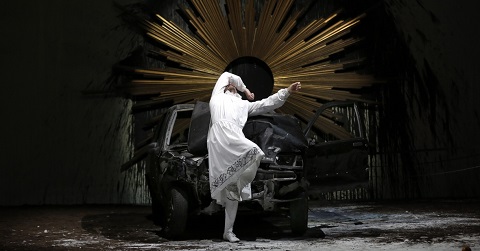Monday, 16 September 2019
Mozart - Requiem (Aix, 2019)
Wolfgang Amadeus Mozart - Requiem
Festival d'Aix-en-Provence, 2019
Raphaël Pichon, Romeo Castellucci, Siobhan Stagg, Sara Mingardo, Martin Mitterrutzner, Luca Tittoto, Ensemble Pygmalion
ARTE Concert - 10 July 2019
Romeo Castellucci's directorial projects are becoming less interested in the traditional narrative aspect of opera direction and more concerned with exploring and representing the spiritual side of humanity within the works. Of course, the works in question have to be capable of possessing this quality, and that's certainly the case for the likes of his La Monnaie Parsifal, his Paris Moses und Aron and his Hamburg Matthew's Passion. More recently he has set about exploring this in other less obviously spiritual works, in Salome for Salzburg and Tannhäuser for Munich, but perhaps the most interesting exploration of the spiritual existing with the physical nature of humanity has been in his stunning La Monnaie production of Die Zauberflöte. Mozart is of course fully open to be explored in this area and nowhere more so than in the Requiem.
Mozart's Requiem however isn't an opera, and the idea of setting it to a manufactured narrative would evidently be presumptuous, if not actually impossible. For the purposes of this Aix-en-Provence production - an ambitious one in Pierre Audi's first season as artistic director of the festival - Castellucci associates the work with a growing awareness of the temporality of human existence as individuals and as a species, as well as the fleeting impermanence of what our relatively brief presence on the planet leaves behind. The best way of looking at this approach to Requiem is that the director is seeking a way to extend the work far beyond its own confines, showing or at least suggesting connections it makes - musical, spiritual and existential - to the condition of being human and being mortal.
To extend the scope of Requiem further for this purpose, Castellucci makes use of several other Mozart sacred pieces and Masonic hymns in including the Kyrie from the Mass in C Minor, O Gottes Lamm, and opens the theatrical presentation of this work with a Gregorian chant. Essentially, this production of Requiem becomes a ritual of song and dance, celebrating life in the face of the certainty of extinction. It's this theme that dominates as, in typical Castellucci fashion, words are projected to the back of the stage, an 'Atlas of Extinction', that enumerates the extinction of creatures that no longer exist, to extinct plants, disappeared lakes, extinct tribes and races, extinct cities, lost languages, religions, buildings and works of art.
It's a fascinating device that really has an impact in conjunction with the performance and the music, showing that as well as being something sad there's also something beautiful in the contemplation of the awareness that all things come to an end. The catalogue however doesn't restrict itself to known extinctions but gnomically reminds us in its list of "present-day extinctions", of the extinction of I, of the extinction even the of the word I, of wind, water, grass, thought, fish in the sea, time, even the extinction of this music. And ultimately of course, an extinction of this day, the 10th July 2019. Indeed, if there is anything that can testify to the glory of human existence over its relatively short presence on Earth, it's Mozart's Requiem. Eternal rest grant unto them.
On the stage meanwhile, Romeo Castellucci makes use of the Pygmalion Vocal Ensemble to enact ritual dances for Mozart's music, placing quite a different character on the work that you would typically get from a solemn concert performance. Moving ever closer towards performance art or art installations, Castellucci has extras representing all the ages of woman (from old age to birth) splatters the stage and bodies with Holi-like coloured power and honey, with soil, spray painting the backdrops, as the chorus move into formations to put on folk dances, a maypole dance and ritualistic representations of life and death, all the while that Mozart's music plays and the backscreen runs through its seemingly endless catalogue of extinction.
Seen in this context it's extraordinarily beautiful, invigorating, thought-provoking and often very moving; but even so, the question remains about whether it is worthy of Mozart's music. I return to that statement at the start of the presumption or impossibility of staging Mozart's Requiem, or believe that it can be elevated to anything greater than it already is. Given that, yes, Romeo Castellucci creates a presentation that is indeed worthy of the piece as a sincere artistic response to this great work. Like Katie Mitchell's and Raphaël Pichon's attempt to do the same for J.S. Bach at the 2014 Aix Festival (Trauernacht), or indeed like Robert Wilson's reworking of Arvo Pärt's sacred music for Adam's Passion, it is of course the music that must be the heart and soul of the production.
That relies of course principally on the musical direction of Raphaël Pichon, the Ensemble Pygmalion Orchestra and Chorus. Even in the open-air conditions of the theatre of the Théâtre de l’Archevêché in Aix in a theatrical presentation, the performances and the singing of the principals Siobhan Stagg (soprano), Sara Mingardo (alto), Martin Mitterrutzner (tenor) and Luca Tittoto (bass) - not to forget the beautiful acapella Kyrie by boy alto Chadi Lazreq - captures all the glory and solemnity of the work. It's not enhanced by the visual representation, but the busy and sometimes strange imagery of the production design doesn't detract from it either. What it does is prompt you to think about not just death but extinction, and as a mass for the death of everything, Mozart's Requiem couldn't be more fitting.
Links: Festival d'Aix-en-Provence



